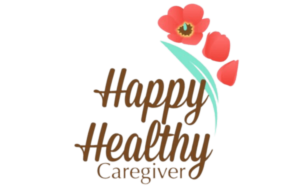A guest post written for Happy Healthy Caregiver by Audrey Goral
In June 2019, my twin brother Cory sustained a high-level spinal cord injury from diving into the Colorado River. His world turned upside down and so did mine. After three months of rehabilitation at Craig Hospital, I moved Cory in with me and became his primary caregiver. Before the accident, we had enjoyed traveling. We still do, it just looks a lot different. I share a lot about our journeys in our online journal. Elizabeth and I met through No Barriers USA where we are both program leaders. She read my post about our recent escapade and thought this experience is something that needs to be shared.
This July, Cory and I spent a week in Colorado. It was Cory’s second and third time flying since his injury. We flew to Denver for a one week re-evaluation at Craig Hospital. For the most part, people were helpful and Southwest Airlines was easy to work with. What does flying with a quadriplegic involve?
Thoughtful Travel Planning
Direct flights are the best option, when possible. We even investigated which type of airplane we book because Cory’s power chair will not fit in the baggage area of smaller airplanes. Good news! Extra bags with medical equipment are always free on most major US airlines. We are grateful for this travel perk as Cory’s turning mattress, night splints, nursing supplies, and medications quickly create extra luggage. Luckily, we didn’t have to fly with the travel commode chair too; because we were staying at Craig Hospital where we could reasonably rent one for the week.
For a week’s trip, we packed all our clothes together in one small bag with wheels. I also took an extra duffel bag for wheelchair parts. I removed anything I could from his powerchair to give the luggage loaders less to break. I’ve heard too many horror stories from wheelchair users arriving at their destination only to receive a broken wheelchair at the gate; ruining their trip, having to battle with airline and insurance claims, being stuck in a loner chair (not specifically modified for them) for weeks. The wheelchair is a paralyzed person’s independence.
Arriving at the Airport
We drove our wheelchair accessible van to the airport and found the last available handicap spot in the long term parking at Burbank Airport. I decided to lug all of our luggage for a ten minute walk from the parking lot to the gate. A smarter option would’ve been to drop Cory off at the gate with our luggage while I go park the van.
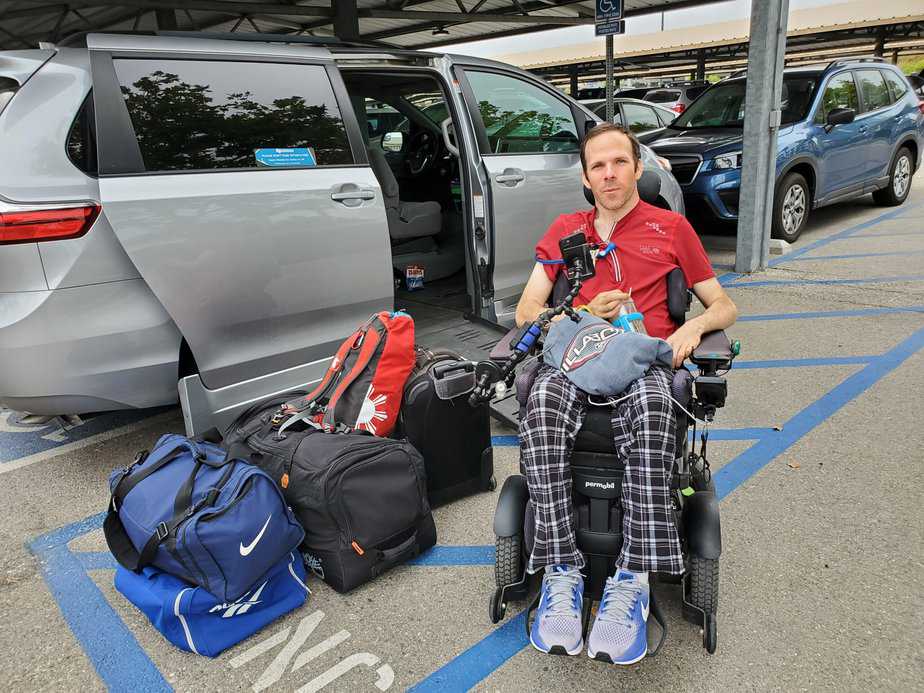
Cory with luggage and van.

Audrey walking from the parking lot to the gate with all the luggage for one week.
At the ticketing counter, we checked two bags (the turning mattress and clothes); important medical bags stayed with us. We also needed a special tag for Cory’s wheelchair in which the airline asked for the make, model, color, battery type, and weight (400 lbs) of the wheelchair. Going through security wasn’t terrible, but it does take a little more time compared to an able-bodied person. Since we used larger airports, we got to use the special assistance line. A TSA agent took Cory to the side while I went through the scanners with our carry-on baggage. Cory got an extra-thorough pat down to make sure he was not smuggling any contraband underneath him or on his wheelchair. Cory had to communicate what his needs are and what he can/can’t do with the TSA agent.
After getting through security, we notified the gate personnel that Cory needs extra time boarding and help transferring to the aisle chair and seat. We have heard about TSA Cares, a program one can contact a few days ahead of time for additional assistance going through the airport. We have yet to take advantage of this but hope to in the future.
Our Flight
Cory and I were the first passengers on and last passengers off the plane. We went down the jetway to the side of the plane, grateful that this process was out of the public eye, and transferred Cory to a tiny aisle chair. It’s a small chair on wheels that can fit on an airplane just to transfer someone onto the plane. He then got transferred into a regular airplane seat with an extra cushion underneath him (that we brought) to prevent skin sores.
Once I got Cory situated and as comfortable as he was going to be, I ran back out to his wheelchair to remove his seat cushion, headrest, thigh guides, hand control, camelback, and emergency bag. Some of this went into the extra duffel bag and some of it went into his medication/nursing supply bag. All of it went with us as a carry-on. By this time, the airline has let other people onto the plane, and now I have an audience while working on the chair which makes me feel uncomfortable.
To prepare Cory’s power chair for the luggage handlers, I laid the seat back down to allow the top of the chair more clearance when going through the luggage compartment doorway and taped a sign, with pictures and arrows, on the seat with instructions not to tip the chair on its side and how to put the chair into push mode. Sadly, we’ve seen a few loaders not read our sign and try to man-handle the 400lb wheelchair. Lastly, I flipped the master power switch off and crossed my fingers that it comes back to us in the same condition.
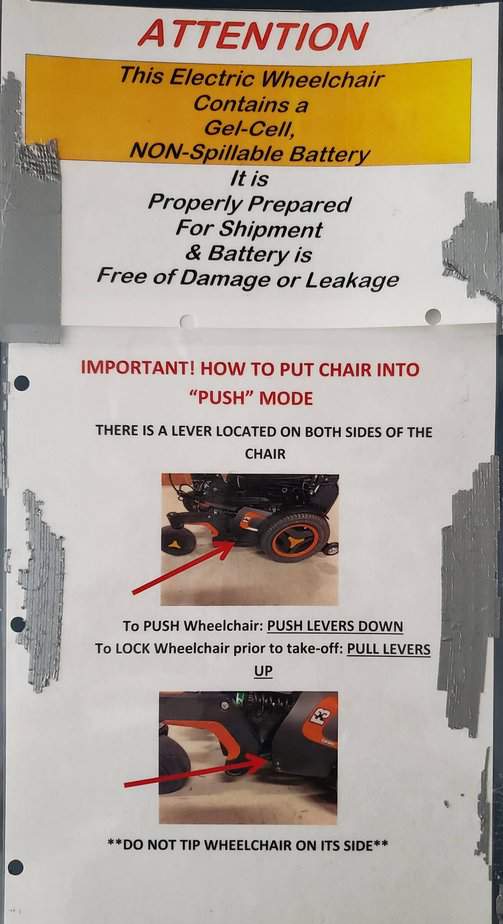
Instructions on wheelchair for airline luggage handlers.
Once in the air, I helped Cory lean forward or to the side for an occasional weight shift and checked his catheter leg bag now and then. There is no way I could get him into an airplane bathroom! I figured I would just fill up an empty water bottle if his leg bag filled up, luckily, he didn’t drink too much fluid before flying so I didn’t have to execute this plan.
When the flight attendants came by for beverage service, it was super awkward because we are in the first row with no lap trays. I could not trust one of those plastic cups in Cory’s hands with a bunch of cold cranberry juice. So, I was stuck holding two precariously full plastic cups of juice while trying to give him a drink and not spill on myself. I was unsuccessful on one flight – but at least it was mainly ice that found its way to my lap.
Another bummer for Cory with his complete cervical fusion is he can’t easily look out the airplane windows. He’s usually in the easiest seat to transfer to, the first aisle seat, but he can’t turn his head to look out the window. Sometimes, I would lean him over or take a picture for him, but it’s just not the same.
We made it!
Once on the ground, we waited for everyone else to get off the plane. We are adamant that Cory will not leave his seat until his wheelchair is unloaded and I have put it back together. This has not been an issue for us but we do feel rushed. The main reason advocating for this is if he transfers to the aisle chair and his wheelchair is not ready, or worse, broken, he will then be stuck in a terribly uncomfortable aisle chair and risk getting pressure sores among other problems. Once Cory’s wheelchair was ready, he got transferred using the aisle chair again.
Upon our return to Burbank Airport, he had an audience of the whole next plane load waiting and watching through the windows at the gate. Cory departed the plane with the Comfort Carrier strapping him in like a straight jacket and belted to the tiny aisle chair. All he needed was a Hannibal Lector mask to look like Steve Buscemi in the movie Con Air! I’m sure the whole process isn’t fun for Cory and it is super nerve wracking for me trying to get everything done while so many people are waiting on us.
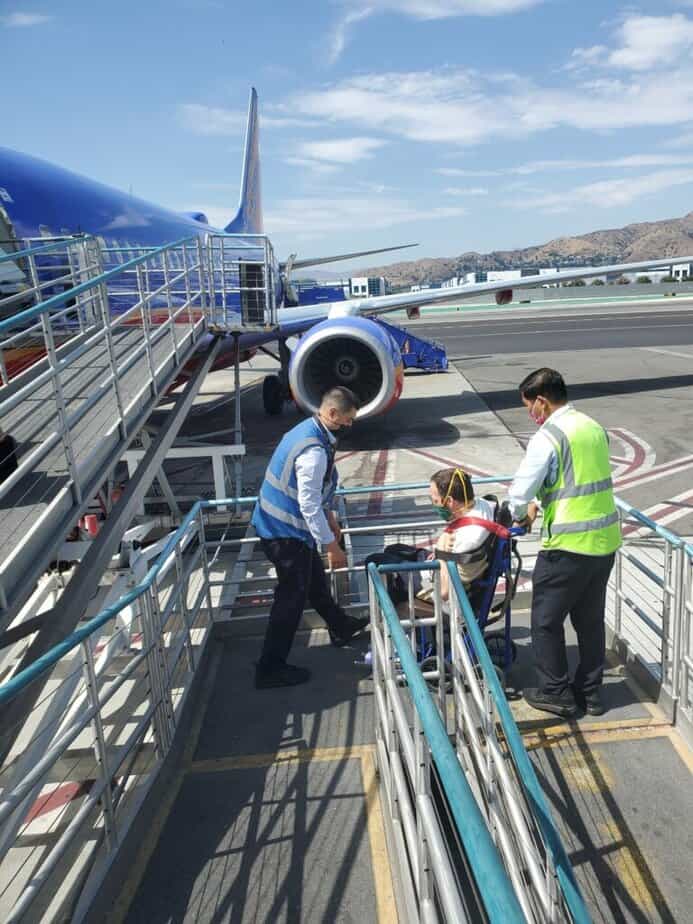
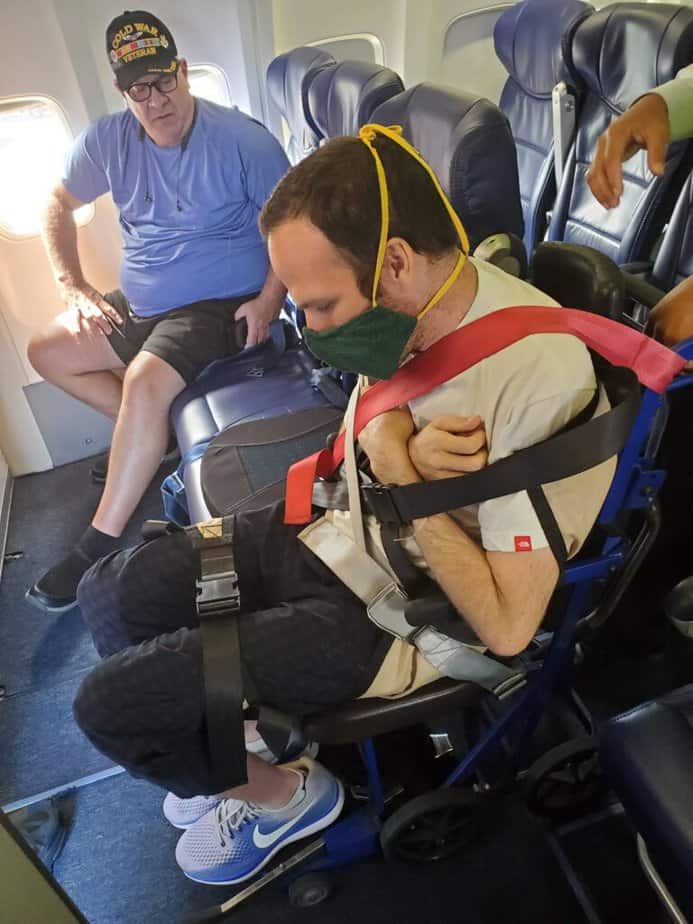
Aisle chair transfer from wheelchair to airplane seat.
I’m grateful our travels went as smoothly as possible and his wheelchair was returned to us in full working condition. All in all, we would fly again, but we prefer driving if our destination is within reasonable driving distance; no more than 8 hours away. It’s logistically so much easier and less stressful!

Audrey Goral is a sibling family caregiver for her twin brother Cory who sustained a spinal cord injury in June 2019. They live together in Rosamond, California. Audrey works full time as a Flight Test Engineer. She is also a volunteer program leader for No Barriers USA and avid outdoor enthusiast. Learn more about Audrey and Cory’s adventures on their CaringBridge journal Cory | Journal (caringbridge.org) and learn tips and strategies that help make their life easier on CoryG SCI – YouTube.
